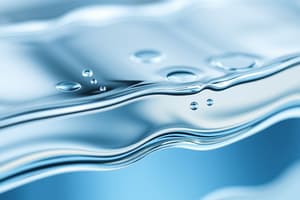Podcast
Questions and Answers
What does a wettability number of 1.0 indicate?
What does a wettability number of 1.0 indicate?
How does a non-wetting fluid behave in porous media compared to a wetting fluid?
How does a non-wetting fluid behave in porous media compared to a wetting fluid?
What role does interfacial tension play in fluid distribution within reservoir rocks?
What role does interfacial tension play in fluid distribution within reservoir rocks?
What does the threshold pressure represent in the context of wettability?
What does the threshold pressure represent in the context of wettability?
Signup and view all the answers
Which equation correctly defines the wettability number?
Which equation correctly defines the wettability number?
Signup and view all the answers
What is indicated by a contact angle of 0 degrees in reservoir rocks?
What is indicated by a contact angle of 0 degrees in reservoir rocks?
Signup and view all the answers
In the context of capillary pressure principles, how does liquid rise in a capillary tube?
In the context of capillary pressure principles, how does liquid rise in a capillary tube?
Signup and view all the answers
What occurs when the wettability of a reservoir rock shifts from oil-wetting to water-wetting?
What occurs when the wettability of a reservoir rock shifts from oil-wetting to water-wetting?
Signup and view all the answers
What does the term 'imbibition' specifically refer to in the context of fluid saturation?
What does the term 'imbibition' specifically refer to in the context of fluid saturation?
Signup and view all the answers
How does wettability impact the laboratory measurement of relative permeability?
How does wettability impact the laboratory measurement of relative permeability?
Signup and view all the answers
What is a contact angle, θ, indicative of in a fluid-solid interaction?
What is a contact angle, θ, indicative of in a fluid-solid interaction?
Signup and view all the answers
What is the main reason why measuring wettability in the laboratory is challenging?
What is the main reason why measuring wettability in the laboratory is challenging?
Signup and view all the answers
According to the content, which minerals are typically water-wet prior to oil migration in reservoir rocks?
According to the content, which minerals are typically water-wet prior to oil migration in reservoir rocks?
Signup and view all the answers
What happens when a non-wetting fluid is placed on a surface already covered by a wetting fluid?
What happens when a non-wetting fluid is placed on a surface already covered by a wetting fluid?
Signup and view all the answers
What does the term 'drainage' refer to in the context of fluid saturation?
What does the term 'drainage' refer to in the context of fluid saturation?
Signup and view all the answers
What is a key factor that alters wettability in reservoir conditions?
What is a key factor that alters wettability in reservoir conditions?
Signup and view all the answers
What does a contact angle of 0 degrees indicate in a wettability test?
What does a contact angle of 0 degrees indicate in a wettability test?
Signup and view all the answers
Which of the following accurately describes capillary pressure (Pc)?
Which of the following accurately describes capillary pressure (Pc)?
Signup and view all the answers
What does a sessile drop ratio of 1 indicate about the wettability of a surface?
What does a sessile drop ratio of 1 indicate about the wettability of a surface?
Signup and view all the answers
How does wettability affect oil recovery in reservoirs?
How does wettability affect oil recovery in reservoirs?
Signup and view all the answers
What is indicated by a contact angle of 90 degrees during a wettability measurement?
What is indicated by a contact angle of 90 degrees during a wettability measurement?
Signup and view all the answers
Which of the following factors influences the capillary pressure in a reservoir?
Which of the following factors influences the capillary pressure in a reservoir?
Signup and view all the answers
What happens to the wettability of a formation during hydrocarbon migration?
What happens to the wettability of a formation during hydrocarbon migration?
Signup and view all the answers
In wettability testing, what is the primary purpose of using a crystal of quartz or a mica surface?
In wettability testing, what is the primary purpose of using a crystal of quartz or a mica surface?
Signup and view all the answers
Study Notes
Interfacial Tension and Wettability
- Interfacial tension exists when two phases (e.g., gas/oil, oil/water) are present.
- It's the force holding the surface of a phase together.
- Measured in dynes/cm.
- Surface tension between gas and crude oil ranges from near zero to approximately 34 dynes/cm.
- Dependent on pressure, temperature, and composition.
Concepts of Surface and Capillary Forces
- In multiphase systems, consider forces at the interface between immiscible fluids (liquid/gas).
- Interfacial tension is the attractive force between molecules at the interface of different substances.
- Water and oil, common in petroleum reservoirs, have interfacial tension between them.
- Water molecules away from the interface experience zero net attractive force.
- Molecules at the interface experience unbalanced forces.
- Interfacial tension affects capillary pressure in porous media.
Water-Hydrocarbon Surface Tension
- Water-hydrocarbon system surface tension varies from approximately 72 dynes/cm for water/gas to 20-40 dynes/cm for water/oil at atmospheric conditions.
- Ramey (1973) published methods for evaluating water-hydrocarbon mixtures' surface tension.
Effect of Different types of surface on Contact Angles
- Surface type affects the contact angle of fluids on surfaces (e.g., water wets silica and calcite preferentially).
- Hydrophilic surfaces have low contact angles and good adhesiveness.
- Hydrophobic surfaces have high contact angles and poor adhesiveness.
Dependence of Interfacial Curvature upon Pore Size and Contact Angle
- Wetting characteristics and capillary tube radius influence water column height.
- Smaller tube radius leads higher water column height, and vice versa.
- Larger adhesion tension results in greater equilibrium height.
- Smaller contact angle leads to higher adhesion tension and greater equilibrium height.
Wettability Concepts and Measurements
- Petroleum reservoirs often contain multiple (two or three) immiscible fluids (water, oil, gas).
- Wettability describes the relative affinity between the rock's surface and each fluid, focusing on which fluid is preferentially adsorbed.
- Wettability is crucial for understanding and predicting reservoir performance. Oil-wet reservoir conditions are often a concern.
Measuring Wettability
- Contact angle test:
- A zero degree angle suggests complete wetting by the denser phase.
- A 90° angle means neither phase preferentially wets the solid.
- A 180° angle indicates complete wetting by the less dense phase.
- Drop ratio can measure wettability, indicating non-wetting (1.0) or wetting (0).
- Wettability directly influences the distribution of fluids in reservoir rock pores.
Capillary Pressure
- Capillary pressure is the pressure difference across an interface separating immiscible fluids.
- It is a result of interfacial tension.
- Interfacial tension tries to minimize the surface area of the interface, creating an imbalance in molecular forces at the interface.
- Internal pressure is higher than external pressure at the interface to maintain equilibrium.
- Wettability varies across pores, and impacts the capillary pressure (i.e., how fluids are held in the pores).
Expressions for Capillary Pressure Under Static Conditions
-Force balance on the interface considering internal pressure, external pressure, interfacial tension, circumference, and cross-sectional area.
Relation between Wettability and Capillary Pressure
- Wettability is dependent on the type of rock and mineral composition.
- Different types of rock have different contact angles, creating different wetting characteristics.
Laboratory Methods for Measuring Capillary Pressure
- Three common laboratory methods:
- Porous Diaphragm Method.
- Centrifugal Method.
- Mercury Injection Method.
- Each method has advantages and disadvantages in terms of time, accuracy, and suitable rock types and materials used.
Capillary Hysteresis
- Capillary pressure curves are not the same during drainage and imbibition processes.
- Different contact angles, and receding and advancing, impact the capillary pressure needed to displace fluid in and out of the pores.
- Wettability changes overtime, dependent on the presence of other fluids and minerals such as oil or connate water.
Effect of Pore Size Distribution on Capillary Pressure Curve
- Unform pore sizes generate a flatter transition zone on the capillary pressure curve.
- Capillary pressure is dependent on pore diameter and wettability and is critical for understanding and predicting fluid distributions and flow in the reservoir.
Conversion of Laboratory Capillary Data
- Useful to convert lab data for reservoir data, by accounting for contact angle and porosity properties in both the reservoir and lab.
Averaging Reservoir Capillary Pressure Curves
- Data averaging is typically done using the Leverett J-function.
- Normalizes capillary pressure curves from different cores to a single average.
- Critical for characterizing and modeling reservoir behavior.
Studying That Suits You
Use AI to generate personalized quizzes and flashcards to suit your learning preferences.
Related Documents
Description
Explore the essential concepts of interfacial tension and wettability in multiphase systems. Dive into the principles affecting surface and capillary forces, especially in the context of petroleum reservoirs. This quiz will challenge your understanding of how these physical properties interact.




